Comprehensive Guide to Effective Backyard Rat Control Techniques
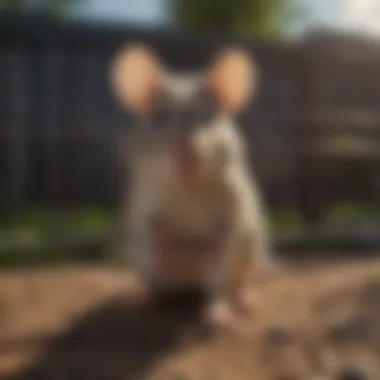
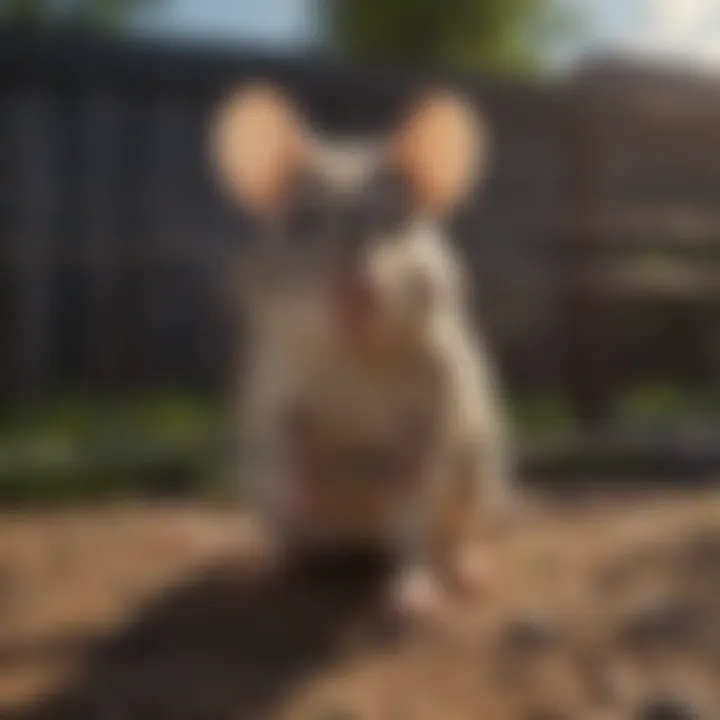
Preventive Pest Control Strategies
- House Exterior Protection
- Yard Maintenance
- Indoor Cleanliness
- Garbage Disposal
- Other Pest Prevention Strategies
- Tips for sealing cracks
- Clearing debris
- Preventing pests from entering
- Essential yard care routines
- Methods for maintaining a pest-free yard
- Expert cleaning tips and techniques
- Maintaining a pest-resistant indoor area
- Efficient waste disposal techniques
- The importance of proper garbage disposal
- Innovative ways to safeguard your living space.
Identifying Pest Risk Areas
- Moisture Prone Areas Inspection
- Crack and Crevice Inspection Guide
- Greenery Inspection for Pest Risks
- Additional Pest Risk Areas
- Identification of damp conditions
- Tips for preventing infestations
- Importance of inspecting access points
- Techniques for sealing cracks and crevices.
- Understanding the impact of greenery on pests
- Guidelines for maintaining a pest-free environment
- Miscellaneous pest risk areas and preventive measures
Effective Pest Control Methods
- Natural Repellents for Pest Control
- Chemical Sprays for Pest Control
- Pest Traps: Effective Pest Control Solutions
- Biological Control Methods for Pest Prevention
- Other Pest Control Methods
- Safe and effective natural solutions
- Utilization of essential oils, herbs, and plants
- Safe utilization of professional sprays
- Eradication of pests with chemical solutions
- Installation and utilization of pest traps
- Safe capturing and removal of pests
- Employment of natural predators for pest management
- Eco-conscious pest control techniques
- Innovative pest control techniques beyond conventional options


Pest Species Identification
- Common Insects in Home Pest Control
- Identifying Rodents for Pest Prevention
- Bird Species Impacting Home Environments
- Dealing with Wildlife on Your Property
- Miscellaneous Pest Species Identification
- Recognition and management of insect infestations
- Various types of insects such as ants, cockroaches, and spiders
- Pointers for identifying and preventing rodent invasions
- Different types of rodents including mice and rats
- Addressing issues related to birds around the house
- Problematic bird species in residential areas
- Effective management of encounters with wildlife
- Understanding the behavior and control measures for wildlife species
- Efficient handling of lesser-known pests
DIY Pest Control Techniques
- Homemade Pest Control Solutions
- Using Essential Oils for Pest Control
- Effective Pest Traps and Barriers
- Top Reputable Pest Control Brands
- Miscellaneous DIY Pest Control Techniques
- Eco-friendly homemade remedies for pest control
- Protection against pests with simple DIY methods
- Natural pest repellent using essential oils
- Creating a bug-free atmosphere at home
- Installation of traps and barriers for pest control
- Management and prevention of pest infestations
- Quality products for home pest management from trusted brands
- Safeguarding your living space with effective solutions
- Unique solutions for various pest concerns at home
Understanding Rat Behavior
Rat behavior is a crucial aspect to grasp when dealing with potential rat infestations in your backyard. Understanding how these rodents operate can provide essential insights leading to effective control measures. By delving into the specific elements of rat behavior such as their characteristics, habitat preferences, and dietary habits, homeowners can adopt a proactive approach towards rat control. Knowing the tendencies and preferences of rats allows individuals to anticipate their movements and implement preventive strategies before infestations occur.
Characteristics of Rats
Physical Features
Rats possess distinct physical features that make them well-adapted to their environment. Their agile bodies, sharp claws, and keen senses contribute to their survival in various settings. One key characteristic of rat physical features is their ability to squeeze through small openings, making them formidable intruders in residential spaces. Despite their size, rats can maneuver through tight spaces due to their flexible skeletal structure. This unique feature enables them to access areas that might seem inaccessible to other pests, posing a challenge for effective exclusion methods.
Reproductive Habits
The reproductive habits of rats play a significant role in their population growth and the rate of infestation. Rats have high reproductive potential, with females capable of producing multiple litters in a year. This rapid breeding cycle emphasizes the importance of controlling rat populations early to prevent exponential growth. By understanding the mating behavior and gestation periods of rats, homeowners can implement timely interventions to curb reproductive success, reducing the risk of widespread infestations.
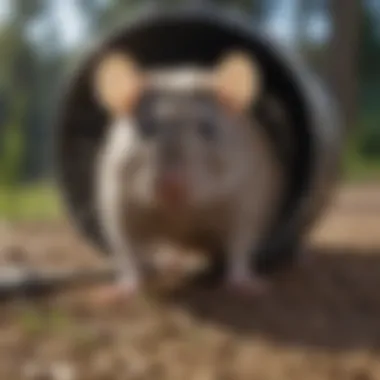
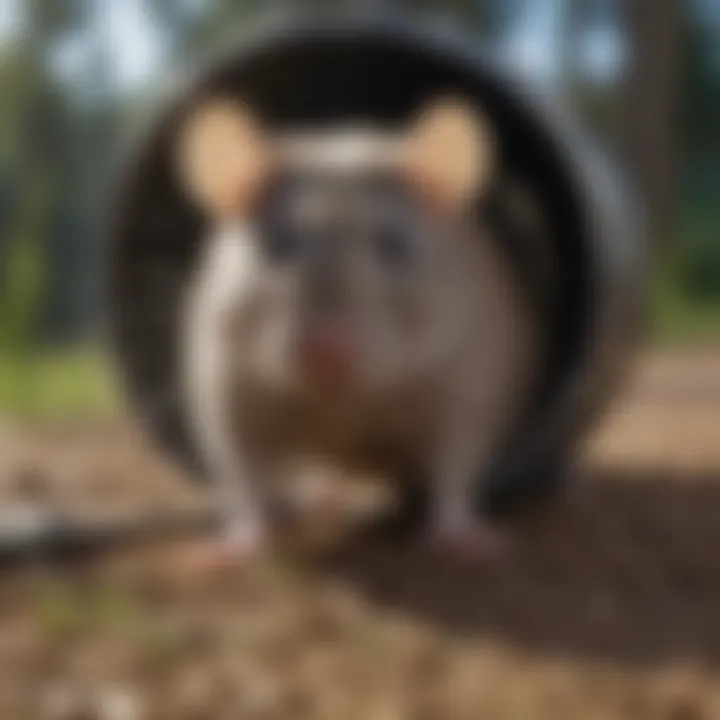
Dietary Preferences
Rats are opportunistic feeders, meaning they can consume a wide range of food items commonly found in outdoor environments. Their omnivorous diet includes grains, fruits, vegetables, and even insects, allowing them to adapt to various food sources easily. One unique aspect of rat dietary preferences is their scavenging behavior, where they actively seek out food remnants and accessible pantry items. This behavior necessitates strict food storage measures and sanitation practices to deter rats from establishing feeding sites in residential areas.
Habitat Preferences
Common Nesting Areas
Rats exhibit specific preferences when selecting nesting locations, favoring warm, secluded spaces close to food sources. Common nesting areas for rats include burrows in gardens, piles of debris, and undisturbed areas in basements or attics. Understanding the appeal of these locations to rats can guide homeowners in conducting thorough inspections and implementing exclusion methods to prevent nesting activities. By addressing potential nesting sites promptly, individuals can disrupt rat habitat preferences, minimizing the risk of infestation.
Environmental Factors
Environmental factors play a critical role in rat behavior and habitat selection. Rats thrive in environments that offer ample resources, minimal disturbances, and suitable shelter. Factors such as vegetation density, proximity to water sources, and availability of hiding spots influence rat activity levels and nesting behaviors. By modifying environmental conditions through landscaping adjustments and structural repairs, homeowners can create unwelcoming environments for rats, discouraging them from frequenting residential spaces.
Preventive Measures
Preventive measures play a crucial role in maintaining a rodent-free backyard environment. By implementing proactive strategies, you can significantly reduce the risk of rat infestations. Securing food sources and sealing entry points are key aspects of preventive measures. Proper food storage is essential to deprive rats of easy access to food, thereby discouraging their presence. By storing food in airtight containers and minimizing food spills, you create an inhospitable environment for rodents. In addition, adopting meticulous cleaning practices further deters rats attracted to food remnants. Regularly disposing of garbage and maintaining cleanliness reduces the likelihood of attracting rats to your property. When focusing on preventive measures, consider the long-term benefits they offer in safeguarding your backyard against rat infestations.
Securing Food Sources
It is imperative to secure food sources as a primary preventive measure against rat infestations. Proper food storage involves storing perishable items in sealed containers or refrigerators to prevent access by rodents. By utilizing sealed containers, you eliminate potential food sources for rats, minimizing the attractiveness of your backyard environment to them. This method significantly reduces the chances of attracting rodents seeking nourishment. Additionally, segregating food waste and ensuring it is properly sealed before disposal further mitigates the risk of attracting rats to your property. Proper food storage is a fundamental aspect of rat control, impacting the overall success of your preventive measures strategy.
Proper Food Storage
Proper food storage is essential in deterring rats from your backyard. By storing food items in airtight containers or refrigerators, you limit rats' access to potential food sources. A key characteristic of proper food storage is its ability to maintain food freshness while preventing odors from permeating and attracting rodents. This method is a popular choice for rat control due to its effectiveness in denying rats easy access to food. The unique feature of proper food storage lies in its ability to discourage pests without resorting to harmful chemicals. While its main advantage is ensuring food safety, a potential disadvantage may be the inconvenience of meticulous storage requirements. However, in the context of this article, proper food storage stands out as a critical component of maintaining a rat-free outdoor space.
Cleaning Practices
Adopting rigorous cleaning practices is paramount in rat control efforts. By regularly cleaning food preparation areas, dining spaces, and disposing of garbage promptly, you eliminate potential food sources that attract rats. The key characteristic of cleaning practices is their role in reducing odors and removing food residues that entice rodents. This method is a beneficial choice for this article as it complements proper food storage by creating an environment hostile to rat infestations. The unique feature of cleaning practices lies in their ability to disrupt the sensory cues that guide rats to food, discouraging their presence. While the primary advantage of rigorous cleaning is a reduced risk of infestations, a potential disadvantage may involve the time and effort investment required for meticulous upkeep. Despite this, the benefits of adopting thorough cleaning practices in rat control efforts are evident in maintaining a rodent-free backyard environment.
Sealing Entry Points
Sealing entry points is a critical component of rat control, preventing rodents from accessing your property. By identifying vulnerable areas where rats can gain entry, you can proactively address potential access points. Effective sealing techniques involve closing off gaps, cracks, and openings that rats could exploit for entry. Identifying vulnerable areas serves as the first line of defense against rat intrusions. By conducting thorough inspections of your property, you can pinpoint areas susceptible to rodent entry and take corrective actions. Effective sealing techniques further fortify these vulnerable points, making it harder for rats to infiltrate your backyard. When focusing on sealing entry points, consider the long-term advantages of preventive measures in bolstering your rat control strategy.
Identifying Vulnerable Areas
Identifying vulnerable areas is essential in fortifying your property against rat intrusions. By recognizing potential entry points such as gaps under doors, vents, or pipes, you can implement targeted solutions to seal off these areas. The key characteristic of identifying vulnerable areas is its proactive approach to preventing rat access. This practice is a popular choice for rat control due to its efficacy in addressing specific points of entry favored by rodents. The unique feature of identifying vulnerable areas lies in its precision in identifying and addressing potential entry points before rats exploit them. While the advantage of this practice is its targeted nature, a potential disadvantage may involve the time and diligence required for thorough inspections. Nevertheless, in the context of this article, identifying vulnerable areas emerges as a critical step in strengthening your defenses against rat infestations.
Effective Sealing Techniques
Utilizing effective sealing techniques is paramount in closing off entry points to rats. By employing materials such as steel wool, caulk, and wire mesh, you can block off potential routes of entry for rodents. The key characteristic of effective sealing techniques is their ability to create a physical barrier that deters rats from infiltrating your property. This method is a beneficial choice for this article as it reinforces the importance of fortifying your home against rodent access. The unique feature of effective sealing techniques lies in their versatility to seal various types of openings and crevices. Although the advantage of these techniques is their immediate impact on rat prevention, a potential disadvantage may involve the need for regular maintenance to uphold the barriers. Nevertheless, the efficacy of employing effective sealing techniques in rat control efforts is evident in safeguarding your backyard from unwanted intruders.
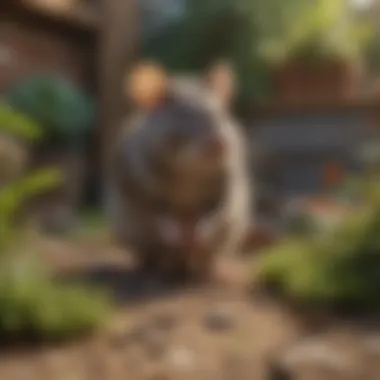

Humane Rat Control Methods
Rat control methods in a humane manner are imperative in maintaining a balance between pest removal and ethical considerations. In this article, the focus is on implementing humane techniques that prioritize the well-being of the rodents while effectively addressing the infestation issue. By choosing humane approaches, individuals can uphold their commitment to ethical pest management practices. It is crucial to consider the lasting impact of the chosen methods, both on the environment and the welfare of the animals involved. These methods aim to resolve the rat problem without causing unnecessary harm or suffering, aligning with a responsible approach to pest control. Implementing humane rat control methods also fosters a sense of compassion and environmental stewardship, promoting harmonious coexistence between humans and wildlife.
Live Trapping
Choosing Appropriate Traps
Choosing the right traps for live capturing of rats is a critical aspect of humane rat control. The effectiveness of these traps lies in their ability to capture the rodents without causing them harm. Selecting traps that prioritize the safety and well-being of the animals is essential in achieving the desired outcome. Live traps are designed to entice rats without posing any threat to their health, ensuring a safe capture process. The key characteristic of appropriate traps is their non-lethal nature, providing a humane alternative to traditional extermination methods. These traps offer a humane solution for individuals seeking to remove rats from their outdoor spaces without resorting to harmful techniques. While live trapping requires patience and diligence, the end result is a humane way of addressing rat infestations and promoting a sustainable approach to pest management.
Release Guidelines
Establishing proper guidelines for releasing captured rats plays a significant role in the success of live trapping efforts. When releasing the rats back into the wild, it is crucial to select suitable locations that offer ample resources for their survival. Releasing rats in unfamiliar territories or environments can jeopardize their well-being, making it essential to release them in locations conducive to their sustenance. Ensuring that released rats have access to food, water, and shelter increases their chances of thriving post-release. By following comprehensive release guidelines, individuals can maximize the effectiveness of humane trapping methods and contribute to the well-being of these animals. While release guidelines require careful planning and consideration, they are pivotal in maintaining a humane approach to rat control and promoting ecological balance.
Natural Deterrents
Plant-Based Repellents
Utilizing plant-based repellents serves as a natural and eco-friendly approach to deterring rats from invading outdoor spaces. These repellents leverage the natural scents and compounds present in various plants to create an environment that is unwelcoming to rodents. The key characteristic of plant-based repellents is their non-toxic nature, making them safe for the environment, humans, and pets. By harnessing the power of botanical scents, these repellents offer a sustainable method of keeping rats at bay without relying on harmful chemicals. Plant-based repellents provide an environmentally conscious solution for individuals looking to protect their backyard spaces from rat infestations while promoting biodiversity and ecological harmony.
Essential Oils
Essential oils have emerged as a popular choice for deterring rats due to their potent aroma and natural repellent properties. The key characteristic of essential oils lies in their ability to disrupt the olfactory senses of rats, making the environment inhospitable to them. By strategically using essential oils known for their rat-repellent qualities, individuals can create an atmosphere that discourages rats from frequenting their outdoor areas. The unique feature of essential oils as rat deterrents is their versatility and ease of application, allowing for convenient and effective pest control. While essential oils offer a natural and aromatic solution to rat infestations, it is essential to follow guidelines for safe usage to ensure optimal results and minimize risks. Incorporating essential oils into rat control measures provides a holistic and aromatic approach to deterring pests, enhancing the overall appeal of eco-friendly pest management practices.
Professional Intervention
Professional intervention plays a crucial role in effective backyard rat control. When faced with a severe infestation that preventive measures and humane methods fail to resolve, seeking professional assistance becomes paramount. Pest control experts possess the knowledge, experience, and specialized tools required to tackle complex rat infestations effectively. Their intervention ensures a thorough assessment of the situation, identification of entry points, and tailored strategies for eradication. By entrusting the task to professionals, homeowners can save time, minimize risks, and achieve long-term rodent control.
When to Seek Help
Signs of Severe Infestation
One of the key indicators of a severe rat infestation is the presence of numerous visible droppings in various areas of the backyard. Rats leave behind distinctive pellet-like feces that can indicate the extent of the infestation. Additionally, gnaw marks on outdoor furniture or structures, such as wooden decking or plastic items, signify an active rat presence. The discovery of nesting materials like shredded paper or fabrics points to a thriving rat population in the vicinity. These signs collectively suggest a significant rat infestation requirung immediate attention.
Choosing Pest Control Services
Selecting the right pest control service is essential for effectively combating rat infestations. When choosing a provider, consider their experience, track record, and reputation in dealing with rodent problems. Opt for licensed and certified professionals who employ safe and humane eradication methods. Verify the company's approach to pest management, ensuring they prioritize the use of eco-friendly products and techniques. By partnering with a reputable pest control service, homeowners can benefit from expert guidance, customized solutions, and ongoing support in maintaining a rat-free backyard.
Integrated Pest Management
Comprehensive Solutions
Integrated Pest Management (IPM) offers comprehensive solutions for addressing rat infestations while minimizing environmental impact. By utilizing a combination of tactics such as habitat modification, exclusion, and monitoring, IPM approaches rats control holistically. IPM emphasizes proactive measures like sealing entry points, removing attractants, and employing traps strategically. This multifaceted approach not only targets existing rat populations but also prevents future infestations, promoting long-term effectiveness.
Eco-Friendly Practices
Embracing eco-friendly practices in rat control is beneficial for the environment, humans, and non-target species. Using non-toxic baits, natural repellents, and sustainable exclusion methods can effectively manage rats without compromising ecosystem health. Eco-friendly pest control prioritizes non-invasive techniques that pose minimal risks to beneficial organisms and biodiversity. By adopting environmentally conscious practices, homeowners can protect their backyard ecosystem while effectively managing rat populations.



